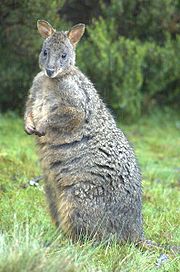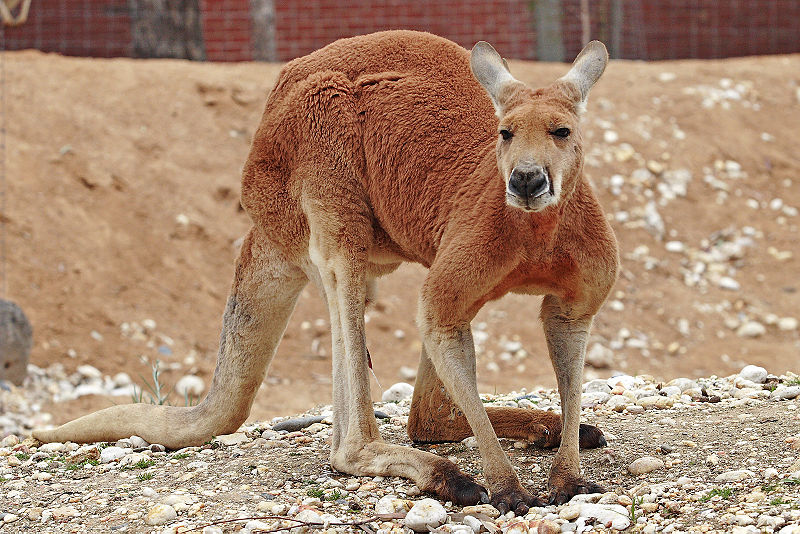National Code of Practice for the Humane Shooting of Kangaroos and Wallabies for Commercial Purposes
 Now extinct on mainland Australia, the Tasmanian Pademelon remains a target of legalised poaching on the island.
Now extinct on mainland Australia, the Tasmanian Pademelon remains a target of legalised poaching on the island.
Australia's Federal Minister for the Environment (etc), Peter Garett MP, controls and administers a legal code permitting various species of kangaroos to be killed for commercial gain and export of meat and hides. Nationally this permission is prescribed under the National Code of Practice for the Humane Shooting of Kangaroos and Wallabies for Commercial Purposes' [The Code]
Under Section 3 of the Code, SHOOTING FOR COMMERCIAL PURPOSES', the following six species of macropods (marsupials belonging to the botanical family Macropodidae including kangaroos, wallabies, tree-kangaroos, pademelons):
1. Red kangaroo (Macropus rufus), in NSW, Qld, SA, WA
2. Eastern grey kangaroo (M. giganteus), in NSW, Qld
3. Western grey kangaroo (M. fuliginosus), in NSW, SA, WA
4. Wallaroo (Euro) (M. robustus), in NSW, Qld, SA, WA
5. Bennett’s wallaby (M. rufogriseus rufogriseus), in Tas.
6. Tasmanian pademelon (Thylogale billardierii), in Tas.
The Code provides that where a kangaroo is wounded, no other animals are to be shot until all reasonable efforts have been made to dispatch the wounded animal. Shot females must be examined for pouch young as soon as the shooter reaches the carcass, and any pouch young must then be killed immediately. Methods which are acceptable as causing sudden and painless death include decapitation with a sharp instrument for smaller hairless pouch young and a heavy blow to the head for larger pouch young.
And this is Australia's federal envrionmental code for its national iconic kangaroos.
Why don't American's shoot their bald eagles - the national bird and symbol of the United States? They have immense pride in their national iconic bird, that's why!
.jpg) The Amercian Bald Eagle (Haliaeetus_leucocephalus).
The Amercian Bald Eagle (Haliaeetus_leucocephalus).
Australians could learn from this association. Besides the immorality of slaughtering native wildlife, in Australia there is grossly inadequate monitoring of the poaching practice to ensure maintenance of species numbers and humane treatment. Poachers can't distinguish between kangaroo species, let alone distinguish threatened from non-threatened, let alone male from female. And do they care anyway? To a poacher, prey is money. It's as if Australian society is stuck in a colonial exploitative mindset. In 2009 we continue exploit our natural resources in the same way as we did in the 19th and 20th centuries.
Gilbert's Potoroo (Potorous gilbertii) is listed as Critically Endangered under the [EBPC Act 1999]
The following macropods are listed as Endangered under the EBPC Act:
* Rufous Hare-Wallaby (Lagorchestes hirsutus unnamed subsp.)
* Bridled Nail-tail Wallaby (Onychogalea fraenata)
* Proserpine Rock-wallaby (Petrogale persephone)
* Long-footed Potoroo (Potorous longipes)
The following macropods on mainland Australia are listed as Vulnerable under the EBPC Act:
* Black-footed Rock-wallaby (Petrogale lateralis) in the MacDonnell Ranges region and also in the West Kimberley region
* Recherche Rock-wallaby (Petrogale lateralis hacketti)
* Black-flanked Rock-wallaby (Petrogale lateralis lateralis)
* Brush-tailed Rock-wallaby (Petrogale penicillata)
* Yellow-footed Rock-wallaby (SA and NSW) (Petrogale xanthopus xanthopus)
* Long-nosed Potoroo (SE mainland) (Potorous tridactylus tridactylus)
Each State in Australia legalises killing of kangaroos legal under licensing conditions that requires the Code to be complied with. But where is the monitoring? Kangaroos poachers do not have to pass a test of species identification, so probably are killing these threatened species. Monitoring of the Code is inadequate to ensure compliance in respect of the humane treatment of joeys, the licensing of kangaroo poachers and of ammunition specifications.
Where is the list of annual prosecutions under the Code on Environment Australia's website? Doesn't exist!
In 2004, Wildlife Protection Association of Australia Inc (WPA) took the previous Minister for Environment and Heritage and Ors to the Administrative Appeals Tribunal (in Sydney) challenging the ferderal government's decision to approve Wildlife Trade Management Plans in South Australia, Queensland and Western Australia. [Case Ref: Wildlife Protection Association of Australia Inc and Minister for Environment and Heritage and Ors [2004] AATA 1383 (14 October 2004)]
WPA argued that the Management Programmes should not be approved because they are inadequate with respect to the killing and locating of young kangaroos and of inaedquate monitoring of kangaroo shooting, amongst other justfications. But R Purvis Q.C. on 14 Oct 2004 rejected the challenge.
At the tribunal, "Mr Pat O’Brien maintained that in his observation shooters will kill a wounded kangaroo if possible, but if it bounds off then it will not be pursued. He also gave evidence about the practice of using "squeakers" – a large joey squeezed until it squeals as a means of attracting other kangaroos answering the distress call. The squeaker, once exhausted, is discarded."
"Ms Egan gave evidence that, according to her records, in 2003, this resulted in 39 per cent of red kangaroos taken being female. For other species the female take rate was lower. In South Australia 51.4 per cent of red kangaroos taken under the Plan are female."
"It was submitted on behalf of the Applicants that the Code clearly contemplates that "larger young" will be ex-pouch. Culling by a shot to the brain is the same method as that specified for the killing of adult kangaroos. Ex-pouch young are treated as adults in being subject to direct culling rather than being left to starve as a result of a mother being killed. However there was criticism of the suffering that resulted from adoption of this procedure in that there is no obligation on a hunter to pursue young-at-foot in order to kill them following the shooting of the mother."

The magnificent red kangaroo is the world's largest marsupial - the adult male stands up to 2 metres tall, weights up to 90kg and can leap 8 metres and travel at 65kph across rugged scrub terrain - yet it remains the target of legalised poaching in Australia's Red Centre.

Recent comments